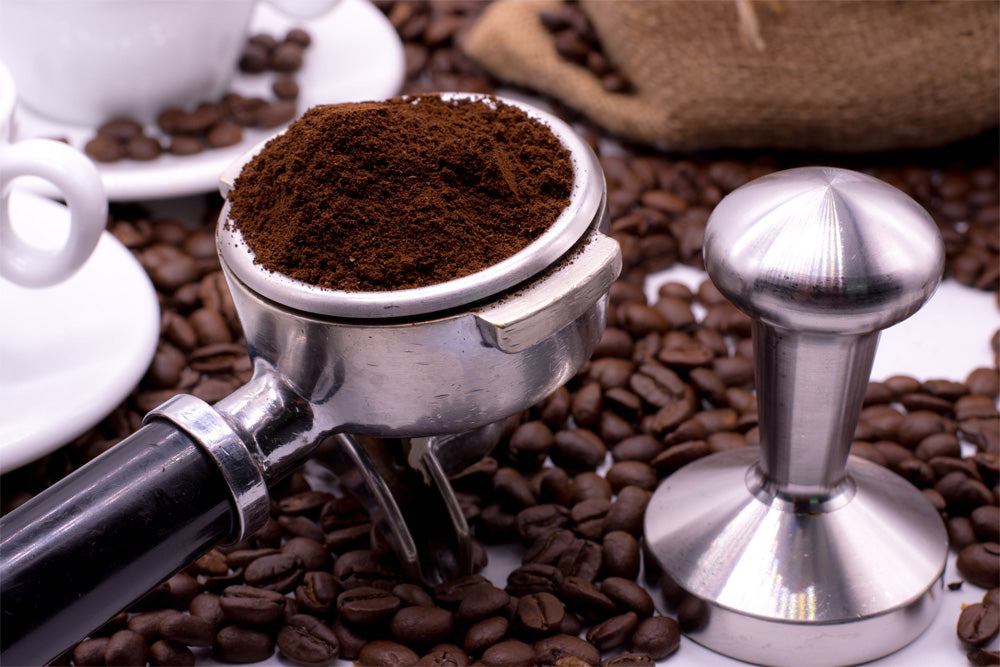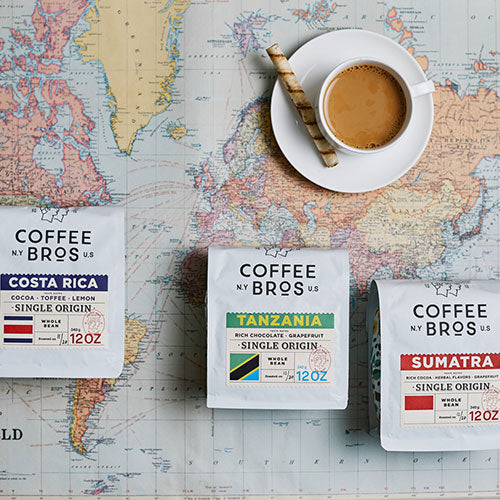November 3rd, 2022
Espresso Roast vs Dark Roast Coffee: All You Need To Know
Overview
- What is the difference between Espresso Roast Coffee and Dark Roast Coffee?
- Is Espresso Stronger than Dark Roast Coffee?
- Is Espresso a Certain Type of Coffee?
- Does Espresso Coffee Have More Caffeine?
- What is the Best Way to Brew A Dark Roast Coffee?
- What is the Best Way to Brew An Espresso Roast Coffee?
Coffee Subscription Deal
Subscribe to Coffee Bros. coffee for 25% off when using code "FTSUB25" at checkout
What is the difference between Espresso Roast Coffee and Dark Roast Coffee:
Espresso-roasted coffees are usually deemed as espresso intentionally by the coffee roaster to inform the consumer, hey, this is an excellent coffee for espresso-based drinks. Dark-roasted coffees can also be great for espresso and across many brewing methods. However, we need to break through some misconceptions around coffee naming conventions, as there is much confusion around espresso.
To begin, the difference between an espresso roast coffee and a dark roasted coffee goes deeper than their appearance in color. The difference touches on the intention of the coffee roaster and how they want to present the coffee to the consumer. If a coffee roaster calls a particular coffee their "espresso blend," one should expect that this coffee will work exceptionally well as an espresso-based drink. Calling a coffee an "espresso" does not mean this coffee would not work well over different brewing methods, which is where much confusion lies.
Is Espresso Stronger than Dark Roast Coffee:
We often see the misconception that an Espresso blend or roast means that the coffee will taste extremely strong or bold. Coffee labeled as an Espresso doesn't always mean that it is roasted super dark but often means that it is at least roasted to medium or darker. Coffee labeled as an espresso means that it will work well with the espresso brewing method and an espresso-based drink like a latte or cappuccino. For coffee to work well within a milk-based drink, the coffee needs to be "developed" a bit further than your average light roast to help bring out the sugars and caramelization of the coffee. A coffee that is roasted medium brings out more caramelization, chocolate and nutty notes, and tends to be richer, which works well as an espresso.
While espresso roasts tend to start at the medium color stage, dark-roasted coffees push beyond the third stage of development (caramelization) and into the carbonization stage, where they pick up those classic notes of smoky dark chocolate. When tasting a medium espresso roast and a dark roast side-by-side using the same brewing method, the dark roast will taste more robust, but that does not mean it has more caffeine than a lighter-roasted espresso roast.
Is Espresso a Certain Type of Coffee:
An espresso is not a specific coffee type but a brewing method. Many coffee roasters may call a particular blend their "espresso blend" as a way to inform consumers that this blend (or Single Origin) will work exceptionally well when making espresso-based drinks.
Many consumers think espresso is a unique type of coffee; in reality, it is no different than any other coffee you drink. The only difference from an espresso blend or coffee is that the coffee roaster geared the sourcing of the coffee and how they roasted the coffee with the espresso brewing method in mind.
For example, let's look at the Coffee Bros. Espresso Roast. Our Espresso Roast is a blend of Ethiopia and Colombian coffee beans to create a bright yet bold profile that cuts through milk but also creates the perfect sweet double-shot espresso. Many customers use this coffee as a pour-over in their Aeropress and Moka pot.
Does Espresso Coffee Have More Caffeine:
The caffeine difference between medium-roasted espresso blends and darker-roasted and coffees is relatively insignificant; however, many think the more robust and bolder taste of dark-roasted coffees means more caffeine. Caffeine content has more to do with the brew method, such as an espresso having higher caffeine content per ounce than a brewed cup of coffee.
There is also confusion due to coffee density being different for dark or light-roasted coffees. The darker the coffee is, the longer it is roasted, and the less each bean weighs. If you were to weigh out coffee by volume (by using a tablespoon), your result would equate to a more robust cup of coffee with a light roast due to its higher density than if you measured by weight using a scale.
What is the Best Way to Brew A Dark Roast Coffee:
Dark-roasted coffee offers numerous brewing options, but the key to making it taste great is the grind size and temperature. If the grind size is too fine, the coffee can quickly taste bitter or burnt. To avoid this, make sure to adjust your grind size to be slightly coarser than you would for a light roast.
The intended presentation of the coffee by the roaster also has a significant impact on how well it will work with different brewing methods. While any coffee can be brewed in any manner, it is always best to start with the method that the roaster intended, whether it be espresso or filter brew.
We recommend starting with a pour-over to fully understand the coffee's complex flavor notes and then moving on to your preferred brewing method or one recommended by the roaster.
When brewing a medium to dark-roasted coffee for pour-over and seeking a bolder taste, aim for a 1:12 to 1:14 ratio. Using grams, this would mean using 25 to 28 grams of coffee for every 340 grams (12 ounces) of water.
Last but not least, dark-roasted coffees work exceptionally well in milk-based drinks. If you are an avid-coffee drinker who prefers milk in their drinks, we suggest leaning toward a medium to dark roasted coffee.
What is the Best Way to Brew An Espresso Roast Coffee:
You guessed it, as an Espresso! Well, we won't stop there as that would be pretty rude as we would love to give you some pointers on brewing a great espresso.
Brewing the perfect espresso takes time to understand the machine you are working with and the coffee.
Here are some general brewing guidelines, tips, and tricks, to move you toward that perfect espresso.
The three most important factors across any brewing method are time, temperature, and ratio (coffee to water). You need to understand each one of these pieces to avoid playing a guessing game on why your espresso is not coming out the way you want it.
Time: Time corresponds to the time it takes to reach your recipe's end weight (the time also includes any preinfusion on your machine). For example, if our recipe calls for a 1:2 ratio, that is, one gram of coffee for every two grams of brewed espresso (18g of coffee to 36g of brewed espresso), the time it takes to reach the 36g is what we are measuring. Ideally, the average time to hit a 1:2 ratio coffee can range between 30 – 40 seconds. Brewing an espresso too long or too short has a significant impact on the final taste; test the extremes and then adjust your grind size to achieve an espresso brewed faster or slower.
*Note, the above assumes your espresso tamping is equal pressure for each shot. We suggest using a spring-loaded tamper like Normcore's V4 to ensure consistency.
Temperature: Temperature refers to the temperature of the water leaving the espresso group head and into the portafilter. Machine temperature readings can vary quite a bit once the water starts to leave the group head (the longer the machine is on or ambient temperature can also affect this number). We suggest starting at 198 – 202 degrees and varying the temperature based on your end goal for the espresso. If brewing a dark espresso, consider lowering the temperature below 200 to offset any bitterness. A lighter roast coffee will do well at higher temperatures.
With the above suggestions, make one change at a time, record what works and what doesn't, and then move on to the next factor.
Brew Ratio or Recipe: Your brew ratio or recipe significantly affects how well your espresso shot will turn out. First, understand the basket size of your machine and how much coffee it can handle. Shoving 20g of coffee into a basket size that can only handle 18g will slow or choke your shot and make it quite hard to hit optimal brewing ratios.
Once you know the amount of ground espresso your basket size can hold, apply your brew ration 1:2 or other to determine how much coffee you should use. As mentioned in the time section, your brew ratio and incorrectly loading your basket can make your shot turn out poorly.
While this is not a full tutorial on how to brew the perfect espresso, we wanted to provide a few tips to help you on your way.




